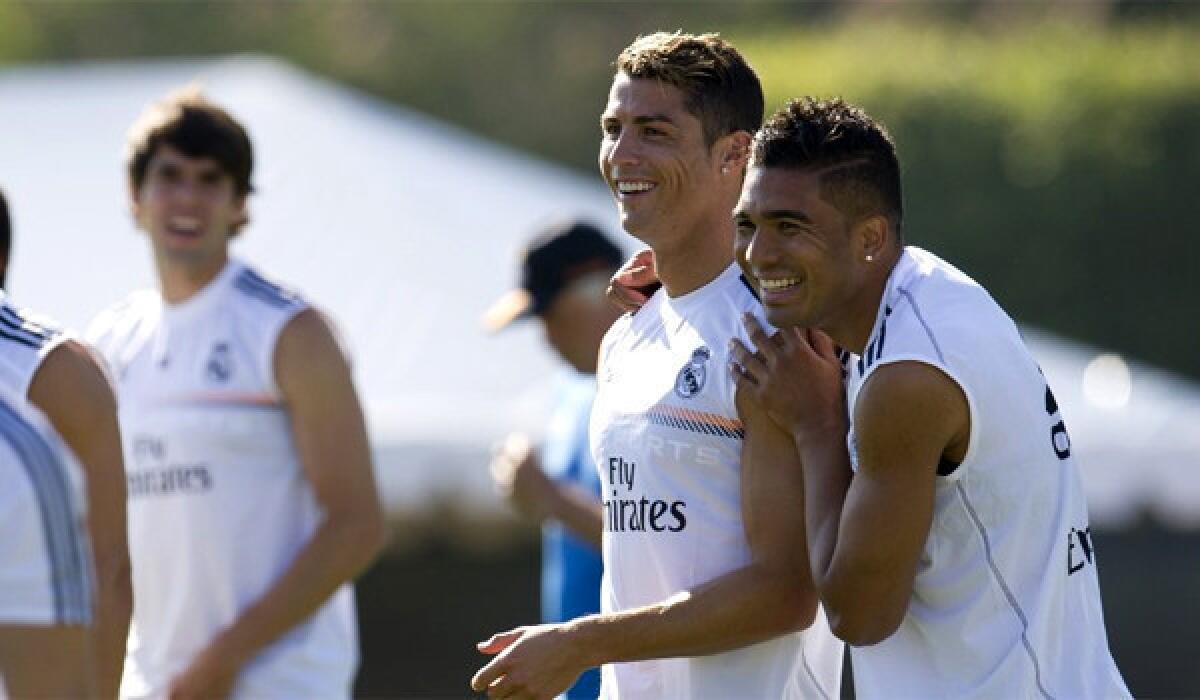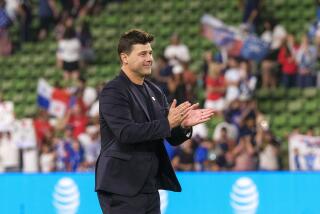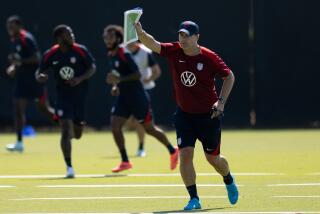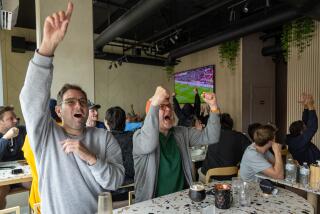European soccer teams come to U.S. seeking fans and money

On Monday, the day after Real Madrid arrived in Los Angeles, about a thousand soccer fans waited for hours in the sun along a sidewalk at UCLA just to catch a fleeting glimpse of superstar Cristiano Ronaldo and his teammates as they whisked by in golf carts before entering a practice facility closed to the public.
This adoration is nothing new for Ronaldo in Southern California. Nor for his team, Real Madrid, which Forbes ranks as the most valuable sports franchise in the world at $3.3 billion.
Ronaldo and Real Madrid have spent part of the last four summers here, leading annual barnstorming tours on the eve of the European league season. Itâs soccerâs equivalent of baseballâs spring training â only instead of training in Spain, Italy or rainy England, many of Europeâs top teams come to the U.S., where they find warm weather, excellent facilities and lots and lots of money.
Seven European teams will play this week in the International Champions Cup tournament, which will stop at Dodger Stadium on Saturday for a doubleheader featuring Real Madrid, Everton of the English Premier League, Italyâs Juventus and Major League Soccer champion Galaxy.
The Galaxy and Real Madrid will open their tournament schedule by facing one another Thursday in Phoenix (7 p.m. PDT; TV: ESPN, ESPND; radio: 1150, 1330). Other teams in the tournament include Italyâs AC Milan and Inter Milan, Spainâs Valencia and Chelsea of the Premier League, who will play in San Francisco; Indianapolis; East Rutherford, N.J.; and Miami.
But those clubs are hardly the only ones summering in the U.S. More than 20 foreign soccer teams, including Mexican league champion Club America, Italyâs Roma and former Brazilian champion Cruzeiro have trained or played in the U.S. since the start of July, drawn by guarantees that range from more than $2 million a game for iconic clubs such as Chelsea and Spainâs Barcelona, to $500,000 for lesser-known teams such as second-tier British club Wigan Athletic.
Add to that a mushrooming fan base and a bevy of major corporations eager to spend millions on partnerships, and a preseason training camp or tournament in the U.S. can prove quite lucrative.
But these visits can fatten more than just bank accounts. When the Premier Leagueâs Manchester City played friendlies in St. Louisâ Busch Stadium and New Yorkâs Yankee Stadium in May â selling out the first game in 20 minutes â club officials said the matches were an important part of their efforts to shore up a U.S. fan base now larger than the teamâs following in England.
âItâs much more of a medium- to a long-term fan-building strategy,â says Diego Gigliani, Manchester Cityâs director of marketing and fan development. âWe know our fans are more and more not in the [United Kingdom].
âSo rather than just watch us on TV or consume the content that weâre able to sort of generate online, thereâs really nothing like physical contact with players in tangible ways.â
And when Londonâs Tottenham Hotspur, one of the Premier Leagueâs most popular teams, toured the U.S. last summer club officials credited that trip with helping to reinvigorate what was an already active fan base.
âA preseason tour enables us to give something back to these fans while also providing potential new fans an opportunity to get to know the club,â says Aidan Mullally, Tottenhamâs senior manager for international business development. âFrom a Tottenham Hotspur perspective, players such as Gareth Bale, Clint Dempsey and Mousa Dembele have helped build a reputation among U.S. fans that we are a club that plays an attacking and entertaining style of soccer and fans want to go and watch that. The success of our U.S. tour in 2012 demonstrates this.â
But if these international soccer tours are popular with the fans, they can be taxing for the players. Manchester City, for example, toured four continents in as many months since the Premier League season ended in May. And Chelsea, which played an exhibition in the U.S. in the spring, then went to Thailand, Malaysia and Indonesia before returning to the U.S. last week for the International Champions Cup tournament.
âThe postseason is now about tours, trips,â says Chelsea striker Fernando Torres, who also played with the Spanish national team in Juneâs Confederations Cup in Brazil, adding another trip and another continent to what was supposed to be his off-season.
âWe went to Asia. Now the United States. When the season ends we have in my head that we canât rest, weâre going to have more tours, more games, weâre going to play football on other continents. And thatâs just part of football today,â says Torres. Over the last three years heâs averaged more than a game a week â with league games, tournaments, World Cup qualifying and exhibitions â a heavy workload typical for top international players.
âIf it was ideal weâd prepare ourselves in another way,â Torres says. âBut I think all the teams ⌠have a similar schedule. So itâs not an excuse.â
In addition to reaching out to fans, the tours also give teams a chance to woo major U.S. companies, who have become increasingly active in European soccer. NBC paid $250 million, and outbid Fox, for the right to air as many as 380 Premier League games in the U.S. in each of the next three years. Worldwide, the leagueâs games are estimated to reach 4.7 billion viewers in 212 countries, reportedly earning it more than $8.3 billion in rights fees over the next three years and making international goodwill tours a vital part of the leagueâs global marketing.
In Spain, where teams cut their own deals, Real Madrid and Barcelona each earn a reported $182 million from TV rights annually, one reason the teams rank first and third in Forbesâ list of the worldâs most valuable sports franchises. Barcelona has an estimated value of $2.6 billion, considerably more than the Dodgersâ $1.6-billion valuation.
And that pot of gold keeps getting bigger throughout Europe. Chevrolet will soon have its name across the jerseys of Manchester United players after striking a seven-year, $559-million sponsorship deal with the Premier League champions. Under Armour has a five-year, $76-million agreement with Tottenham and sportswear company Warrior has kit deals with Englandâs Liverpool and Sevilla of Spainâs La Liga.
Nike, meanwhile, has its swoosh on jerseys in each of Europeâs top seven leagues.
âLook at Juventus,â Charlie Stillitano, organizer of the International Champions Cup, says in singling out Italyâs Serie A champion. âTheir parent company owns Chrysler Jeep. Who would have said that a few years ago? Nike is their main sponsor. And this is an Italian team.
âSo the U.S. is important for them and their fans. Generally in Europe youâre born into a team. Here you can adopt a team from Europe. So teams can scramble to have those fans.â
Americaâs stake in Europeâs top sport is growing in other ways as well. Six of the 20 teams in the English Premier League now have U.S. owners. And when Sheik Mansour bin Zayed al-Nahyan, head of the investment group that owns former Premier League champion Manchester City, joined with the New York Yankees last spring to fund an MLS expansion team in New York, the synergy between soccer on the two continents grew even stronger, making future summer training trips across the pond even more likely.
Even the competition available in the U.S. has become a draw. In addition to the Galaxy, half of the MLSâ 18 other teams will play against top European teams this summer, offering a level of play the visiting clubs would have a tough time finding anywhere else.
âQuality preparation is essential,â says Tottenhamâs Mullally. âTeams are looking for excellent facilities, a high caliber of opposition and a competitive environment to ensure the players are ready to hit the ground running as soon as the season starts.
âI think it is fair to expect the U.S. to remain a key destination for preseason tours.â
Twitter: @kbaxter11







